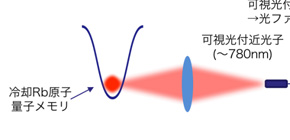
Accessing quantum memory using telecom photonic technology
A solution to a long-standing problem of secure quantum communication
Professor Imoto’s research group at Osaka University built an elemental quantum communication system including a cold Rb atomic ensemble based quantum memory, a single photon frequency converter, and superconducting single photon detectors and demonstrated access to quantum memory with telecom photon detection in collaboration with Senior Researcher Mukai's group at NTT, Miki's group at NICT, and Professor Koashi of The University of Tokyo. In most cases, so far, access to an atomic quantum memory has been performed only by photons near visible range, which is not suitable for long distance fiber communication (Fig.1). The research team has developed a single photon frequency converter and filled the gap between the frequencies, and then demonstrated single atomic state preparation in a cold Rb atomic ensemble by telecom single photon detection with superconducting single photon detectors (Fig. 2). Such a quantum communication system opens up the next generation of long distance secure quantum communication (Fig.3).

Figure 1

Figure 2

Figure 3
Abstract
Telecom photonic quantum networks with matter quantum systems enable a rich variety of applications, such as long-distance quantum cryptography and one-way quantum computing. Preparation of a heralded single excitation (HSE) in an atomic ensemble by detecting a telecom wavelength photon having a correlation with the atomic excitation is an important step. Such a system has been demonstrated with a quantum frequency conversion (QFC) to telecom wavelength employing a Rb atomic cloud. However, the limited wavelength selection prevents the next step toward linking various kinds of matter quantum systems through long-distance fiber-based quantum communications. Here we for the first time, demonstrate HSE with a solid-state-based QFC and a detector for a telecom wavelength that will have the great advantage of the utility of mature telecom technologies. We unambiguously show that the demonstrated HSE indicates non-classical statistics by the direct measurement of the autocorrelation function.
To learn more about this research, please view the full research report entitled “ Heralded single excitation of atomic ensemble via solid-state-based telecom photon detection ” at this page of the Optica website.
Related link
